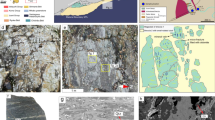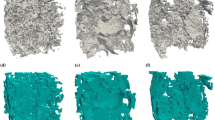Abstract.
A unique regime of groundwater flow in large limestone aquifers in China is presented in the context of variation of anisotropy of permeability tensors with depth. The limestone aquifers are composed of an upper region where the permeability ellipsoid is upright or prolate and characterized by Kz>Kx and Kz>Ky, a transitional zone, and a lower zone whose permeability ellipsoid is horizontal or oblate and characterized by Kz<Kx and Kz<Ky. The transitional zone partitions the whole limestone into these two upper and lower parts. The principal permeability values Kx, Ky, and Kz in these permeability tensors all decrease simultaneously and logarithmically with depth. When groundwater is discharged out of both the upper part and the lower part of the limestone aquifer by permanent mine drainage at a high yield, an initial regional drawdown cone of groundwater is formed in the aquifer domain. Thus the karst collapse may occur catastrophically. However, a special discontinuous flow environment in this permeable continuum, which we refer to as "double water table flow", could appear in a large limestone aquifer if groundwater is further abstracted out of the lower part of the aquifer through mine drainage even at small yields. Under this condition – where a second water table appears beneath the upper high stage water table due to mine drainage activity at the lower level of the aquifer – the previous regional drawdown cone disappears and the initial groundwater table reappears. Consequently, the high stage of water table is re-established in the upper part of the aquifer, and the karst collapses come to a stop. During the process of tapping the lower aquifer zone, a local drawdown cone, separated from the original groundwater table, gradually takes shape in the lower part of the aquifer. This lower water table migrates downwards with depth as controlled by mine drainage. In this case, the total yield of mine drainage does not increase with depth and approaches a constant value. Although the flow rate of groundwater is uninterrupted between these two parts of the aquifer, an unsaturated region of water cuts off the static pressure in the middle portion of the aquifer. Such an unusual phenomenon can be regarded as a special discontinuous flow condition in a permeable continuum. "Double water table flow" or DWTF is proposed as a new concept in applied hydrogeology and can also be developed into a new technique for karst collapse prevention. It is completely different from some partial discontinuous appearances of groundwater pressure or separations of flow systems that result from a stratiform aquifer combination on groundwater discharge. As the mine drainage changes from the upper part to the lower part in a large limestone aquifer, the original continuous flow (a single water table flow) of fracture water can finally evolve into a discontinuous flow (a double water table flow). The occurrence mechanism of DWTF has been fully demonstrated by the hydraulic simulation of fracture water in an infiltration tank. The prerequisite to the evolution of DWTF in a large limestone aquifer is that the permeability ellipsoid of the lower part of the limestone aquifer must be horizontal or oblate. The economic and environmental benefits of the discontinuous fracture water flow are also briefly pointed out.
Similar content being viewed by others
Author information
Authors and Affiliations
Additional information
Electronic Publication
Rights and permissions
About this article
Cite this article
Kaiming, T., Fusheng, H. & Li, W. Discontinuous flow of fracture water: a new technique of karst collapse prevention. Env Geol 40, 1347–1352 (2001). https://doi.org/10.1007/s002540100371
Received:
Accepted:
Issue Date:
DOI: https://doi.org/10.1007/s002540100371




